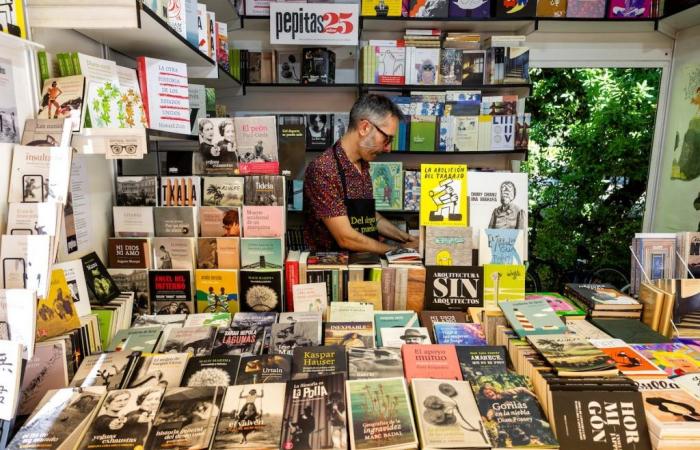With what it costs to publish a book and then, with few exceptions, it barely passes a sigh on the news tables. It is a mantra in the sector: how much is published in Spain, how short a novelty lasts, what competition for physical, media, and mental space. But books have a transcendent life beyond novelty: that Beyond books is the catalog or editorial collection. And although it is a Beyond, many titles are still very much alive. At the Madrid Book Fair, which comes to an end this Sunday, the background is very present in the publishers’ booths, where they can display it with pride and without so much space-time limitation.
The bottom is very important: despite its lower visibility, the majority of annual sales come from its depths. In all genres it exceeds 50% of sales and on average it represents 68%, according to GFK data for 2022. According to the auditor herself, many publishers neglect their funds and would get more out of them with more promotion or, simply, updating the metadata regularly. The bottom is like a soup that must be stirred frequently so that the stumbles do not sink: past titles need energy to stay afloat.
Every discovery, a novelty
“We like to think that a novelty is any book that reaches a reader for the first time,” says Pilar Reyes, editorial director of several literary imprints of the Penguin Random House group, such as Alfaguara, Random House, Lumen or Caballo de Troya. That is to say, the books in the background are also new to many people and should be treated that way. Give examples: Hopscotchby Cortazar, or Essay on blindness, by Saramago, are books that are constantly discovered by new readers. How beautiful it is to turn 18 and immerse yourself in that Paris of the enormous Argentine cronopio.
“Working with the background is one of the things that allows an editor more creativity; it is stimulating to think about strategies so that the catalog remains alive,” says Reyes. Some common strategies are to make special editions with new prologues or redesign the covers of the work of an established author. A notable example is the edition that Alfaguara published of One hundred years of loneliness, by García Márquez, on the author’s eightieth birthday, accompanied by critical texts by Mario Vargas Llosa, Víctor García de la Concha and Sergio Ramírez, in collaboration with the Royal Spanish Academy and the Association of Academies of the Spanish Language. Another example was the relaunch of The world of late antiquity (Taurus), by Peter Brown, which was an editorial hit. “Our proposal is not only to increase the number of new titles but to rethink readings from the past in the present,” adds the editor.
Although the fund is essential for the publishing business, since the pandemic, with the increase in online sales, its weight in billing has been growing with respect to the novelty. After all, on the Internet the new products and the catalog enjoy a more balanced accessibility, unlike in physical bookstores, where the new titles shine brilliantly, while those in the background hide on the shelves or also shine, but for his absence.
fair background
Although at the Book Fair the appearances of the writers who sign their releases are colorful, it is also a favorable setting for publishers to show their chests for everything they have published and not just for the hype of the moment. Here there is time (two weeks) and space (a booth) to show (and sell) the bookish heritage gathered with the accumulated work.
There are those who defend the bibliodiversity that the fund provides. “It is very good that publishers come to the fair to show their collections, because in the bookstore booths, novelty usually prevails,” says Matilde Martínez Sallés, editor of Godall, which debuts this year at the fair with its catalog of 40 books in Spanish (they have many more in Catalan). “We want to fight against the dictatorship of novelty,” she says. They demand that fewer books be taken out, that we go slower. “We have to get out of that damn wheel of news imposed by large groups, where books only last two or three weeks,” says the editor.
At Captain Swing they disembark with their entire catalogue, made up of some 400 titles, to put it on display for the visitor. “In addition, for the fair we print a catalog with all our titles, starting with the first one, and each year, of course, it gets thicker. We give it to readers, there are those who come to look for it expressly,” explains Verónica Vicente, head of communications. “Through it you can discover books that may no longer be on the radar,” she adds. The other way to take advantage of the fund is social networks: since Captain Swing is dedicated to discussing hot socio-political topics, it is common for some current event to allow them to bring up some of the works in their extensive catalogue. From Palestine to gentrification, through taxes, access to housing or the rise of the extreme right.
At Pepitas de Calabaza they also bring all their material, more than 380 titles. “There are publishers that are more focused on news, but we consider ourselves a deep-rooted publisher,” says Víctor Sáenz-Díez, who tends the booth with an apron, as if he were a book seller. This implies not only choosing the texts thinking about their survival beyond novelty, but also making longer runs without worrying about them not being sold out at launch. In Logroño they have the Semilla Negra store where you can find their entire catalog displayed in front, as if it were an old video store rather than a bookstore. “Many people come to the Fair to look for those back books that are not easily found in bookstores,” says Sáenz-Díez. During the year they “invent things”: they look for anniversaries to air some books or they create playlists with songs related to some title (they did it with books like Fidelaby Elvira Valgañón, or Philosophy is La Polla, by Tomás García Azkonobieta). “Our fund is very alive.”
“Our driving force is the bottom line,” says David Lacal, salesman for the Kalandraka publishing house, “there are some classics that have been selling for 20 or 30 years and continue. They have no end.” It sounds true, because this publishing house focused on children and youth has to its credit some of the long sellers that experienced parents recommend, generation after generation, to novice parents, those who are in all nursery schools (for example, the collection From the cradle to the moonby Antonio Rubio and Óscar Villán or What does the moon taste like? by Michael Griejniec). Word of mouth works at full speed. In the Kalandraka booth they have a certain strategy: during the week, when there is a little more calm and time to give explanations, they place some of their most underground books in the most visible positions; On the weekend they release their most salable material, their greatest hits. “Our goal is to get titles that last over time,” he says.
The pocket book
A classic option to continue playing with the catalog is the pocket book: after editing trade (that is the name of the original hardcover edition), some titles, those that acquire a certain notoriety and sustained sales, are re-released in paperback format. That is what the Debolsillo label is dedicated to with the Penguin Random House catalogue. “What we try to do with current authors is to create synergies, so that new developments in trade take the reader to paperback books, and let the paperback books take him to the news in trade”explains editor Lucía Luengo. “We look for the ideal format for the publication of each work,” she adds.
An example: each novelty from the personal growth author Robin S. Sharma causes books in the catalog to be sold, such as his now classic The monk Who Sold His Ferrari. When readers become enthusiastic about an author they try to reach all of his work, and all of his work, logically, is in the catalog. Furthermore, paperback editions can coexist perfectly with other formats, as readers may prefer different sizes, qualities and prices depending on whether it is a book to read on the subway or to look good as a Christmas gift.
At the bottom of the fund there are really old works that continue to pay off. It is the example of The Art of War by Sun Tzu, recently re-released, or the long seller inexhaustible Meditations, by Marcus Aurelius (especially now that Stoicism is in fashion). “It is sometimes said that a best seller “has been on the best-seller lists for I don’t know how many weeks,” says Luengo, “we can say that Marcus Aurelius has been best seller for two thousand years.”
All the culture that goes with you awaits you here.
Subscribe
Babelia
The literary news analyzed by the best critics in our weekly newsletter
RECEIVE IT






